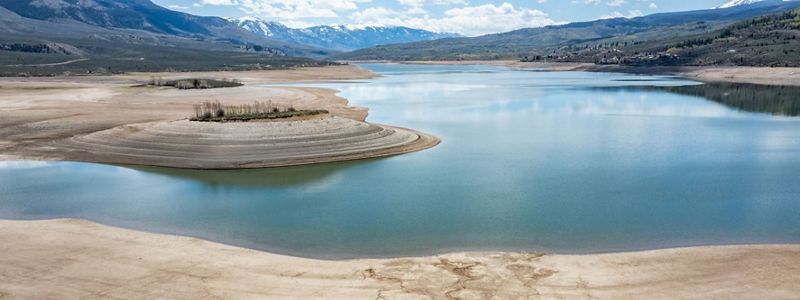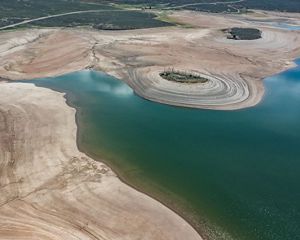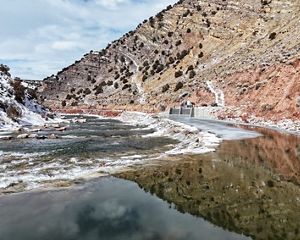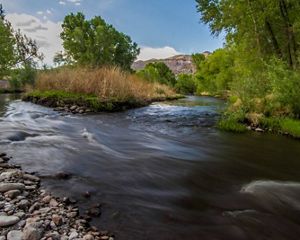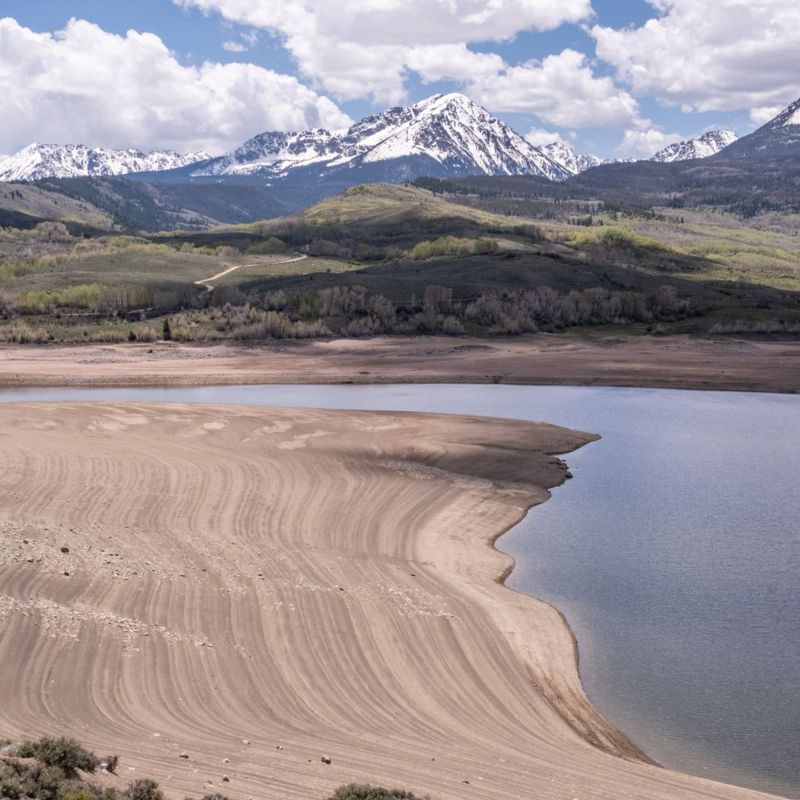
A River in Crisis
Dire conditions in the Colorado River Basin call for collaborative solutions.
Paul Bruchez is a busy man. On any given morning, the Colorado rancher and father of two is checking soil moisture levels, fielding calls from journalists from his tractor or meeting with extension specialists about planting schedules. His family has worked on the land for generations. But he’s not afraid to leave tradition behind and try new things.
On his 6,000-acre ranch outside Kremmling, he works with The Nature Conservancy (TNC) and other conservation groups to experiment with different crops and irrigation strategies. He and his neighbors are constantly tweaking the formula in hopes of finding a better way to farm, a way that uses less water… because every year, water becomes scarcer.
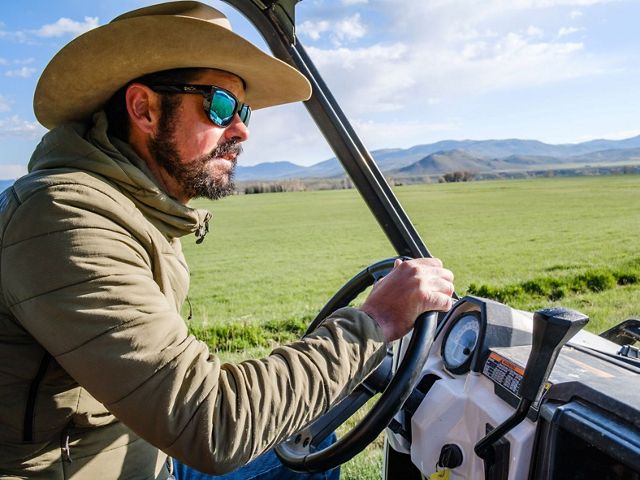
An Epic Drought
It wasn’t always this way. There used to be wet years and dry ones, but ranchers could count on eventually getting a year of good snow. In spring, the thaw would fill the river to its banks, spilling into the floodplain and recharging groundwater supplies.
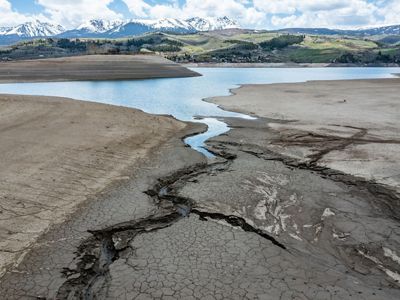
Now, 22 years into the longest-running drought in the history of the American West, the water levels in the Colorado River are so low that downstream states like Arizona aren’t getting the water they expected. It’s an unprecedented challenge for the Colorado River Basin. Drought and rising temperatures due to climate change have accelerated evaporation from reservoirs, melted snowpack faster so that rivers run dry earlier in the season and parched the soil so it soaks up precipitation before it even reaches the river. This means less water available for agriculture, wildlife and people. At this point, even years of good precipitation won’t be enough to restore conditions in the river.
Quote: Paul Bruchez
We’re facing some of the most water-scarce times ever. A lot of my neighbors live on small tributaries, and those streams don’t flow anymore. So, everybody is on board that climate change is happening.
Feeling the Heat in the Colorado River Basin
Today, the Colorado River is at a crossroads as we witness climate change hitting the river in multiple ways. Even the word “drought” no longer goes far enough to describe what’s happening. Instead, the Colorado River Basin is becoming permanently hotter and drier due to climate change—putting major cities, some of the largest food producers in the country, and a vast and interconnected river ecosystem at risk.
Temperatures have risen faster in this region than anywhere else in the lower 48 United States. Portions of the Basin have warmed more than double the global average. The average flow of the Colorado River has already declined nearly 20% since 2000, with half of that attributable to rising temperatures. Temperatures in the Basin are predicted to rise another 2–5 degrees Fahrenheit by 2050, which could reduce river flows by another 10 to 40%.
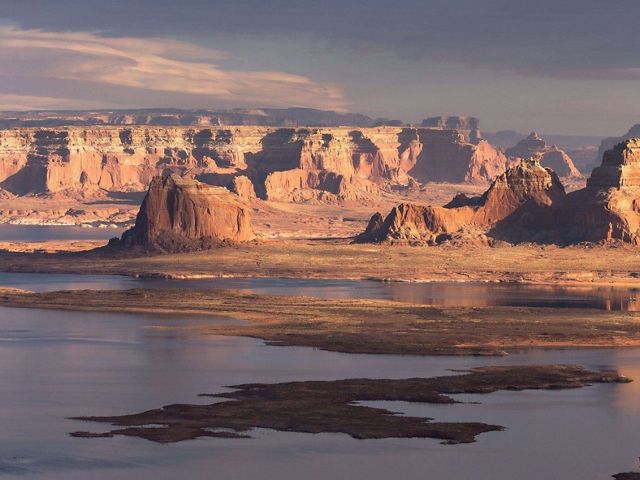
In addition to causing soaring temperatures and water scarcity, climate change brings more intense wildfires, which result in erosion that threatens rivers and water supplies. Two serious fires scorched nearly 200,000 acres near Bruchez’s property in 2021. When the rains do come, runoff from the fire-scarred area carries so much sediment into the river that he’s unable to operate his fishing business.
As the population in the Colorado River Basin continues to grow, the demand for water will increase. The water in the Colorado River needs to serve municipal, agricultural, Tribal and recreation needs, and enough water needs to stay in the river for fish and wildlife, including more than 150 species that are at risk. It’s a dire situation with no easy answers.
But that doesn’t mean there’s no hope. Although the problems are serious, there are many potential tools that we can use to manage water supplies in the Colorado River, and there is a growing collective desire to address the problem.
Quote: Paul Bruchez
“Instead of throwing up our arms and saying the system has failed, we’re finding partners and solutions. We’re not pretending it’s going to get better and we’re not giving up; we’re in solutions mode.
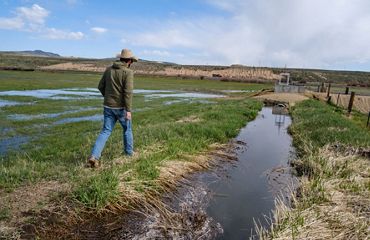
Federal Action to Manage the Water Crisis
Alarmed by the growing crisis, the federal government has taken a series of unprecedented actions to try to navigate this uncharted territory. In August 2021, the government implemented a Tier 1 shortage for the first time ever. The Tier 1 declaration meant that the farthest downstream states that depend on the river’s water, Nevada and Arizona, as well as Mexico, would not receive their full allocation of water in 2022.
The federal Bureau of Reclamation also conducted an emergency release of water from reservoirs in Wyoming and Colorado, in order to boost water levels in Lake Powell. In both Lake Powell and Lake Mead, low water levels were putting hydropower infrastructure at risk and threatening to cut off drinking water supplies for Page, Arizona, and chapters of the Navajo Nation.
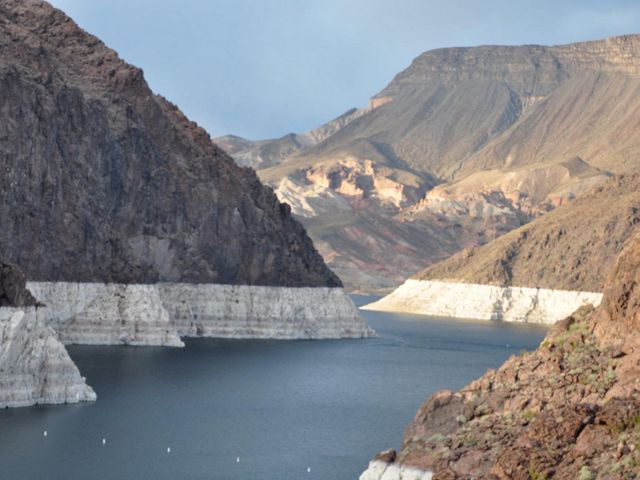
In addition, in May 2022, the federal government decreased water releases mid-year from Lake Powell for the first time ever. Then in June, the government called on states to find an additional 2–4 million acre feet (MAF) of water savings in 2023. To put that in perspective, Arizona’s entire share of the Colorado River is only 2.8 MAF, and Colorado’s annual share is a little over 3 MAF.
State and Local Action to Reduce Water Use
The federal decision to step in has had a ripple effect, prompting action at state and local levels. In December 2021, California, Arizona and Nevada signed agreements to temporarily take less water from the river, in hopes of stabilizing water levels in Lake Mead. In April 2022, states in Colorado’s Upper Basin agreed to release water from their reservoirs to Lake Powell.
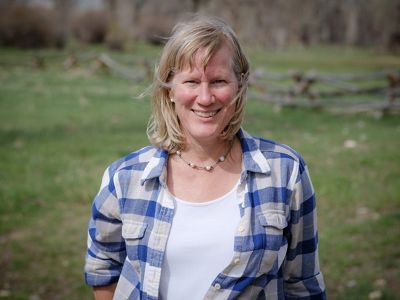
These historic actions provide some short-term relief, but they only address the immediate crisis. “The Basin needs long-term solutions, not temporary steps that only buy us a few more months,” says The Nature Conservancy’s Colorado River program director Taylor Hawes. And, she adds, “we need to bring all the stakeholders to the table, including those like Tribal Nations who have been traditionally excluded from decisions about water.”
Bringing Partners Together for Long-Term Solutions
TNC is working to find answers. We’ve been involved in the Basin for more than 20 years, building relationships with farmers, ranchers, municipalities, states, Tribal Nations and many other partners, as well as developing strategies that reduce pressure on existing water supplies and increase the landscape’s resilience. TNC also has a reputation for being able to connect with groups that historically haven’t seen eye to eye.
“There are ways to use less water,” explains Aaron Derwingson, water projects director for TNC’s Colorado River Program. “The cool thing about TNC is that we work on everything, from developing and testing tools with partners to address water shortages, to figuring out the economics that support these tools, and helping generate the political will to implement them at scale.”
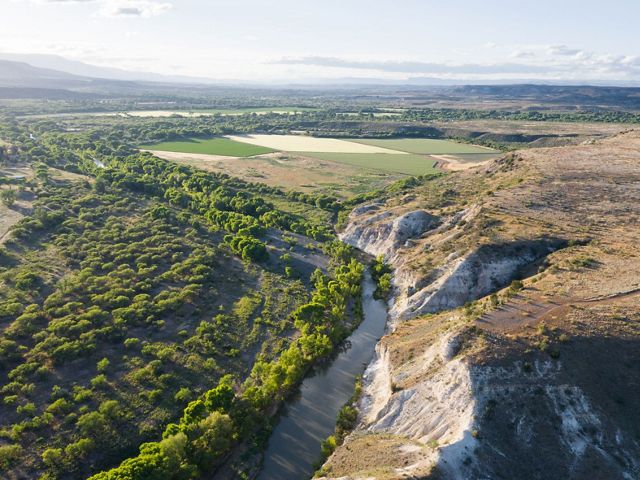
Here are some of the tools we’re using to address the situation:
- Starting water banks. In Utah, these are voluntary agreements among users to share a water resource. In exchange for not using their share of water, users receive compensation and legal protection for their water rights. Water banks create more flexibility than the “use it or lose it” rule that has traditionally governed water rights in the West. With a strong coalition of partners, TNC is creating Utah’s first water bank, on the Price River, which will help meet local users’ needs while enhancing flows to benefit endangered fish.
- Using nature-based solutions. About 90% of the water in the Colorado River Basin starts as snow or precipitation in forests, making these landscapes our largest natural reservoirs. We are working throughout the Basin to advance forest management that mitigates wildfire danger in critical watersheds. We’re also working with landowners on the Upper Green in Wyoming to restore wet meadows, improving the land’s ability to retain water through low-tech infrastructure.
- Rethinking agriculture. In the Verde Valley in Arizona, we’re using crop switching, water reuse and more efficient irrigation to keep water flowing. We’re also exploring scientific approaches to irrigation with agricultural producers like Bruchez. Replacing thirsty crops with more drought-adapted crops like sainfoin (an alternative to grass hay) can make a huge difference.
- Upgrading old infrastructure. Obsolete irrigation systems can waste a lot of water, so we’re upgrading them on the lower Yampa River in Colorado to protect federally endangered fish.
- Creating new partnerships. TNC brokered a first-of-its-kind agreement in which the Jicarilla Apache Nation will lease up to 20,000 acre feet of their water to the New Mexico Interstate Stream Commission. The water will bolster environmental flows and protect sensitive fish in the San Juan River, while income from the lease will support the Nation’s economic development.
It’s clear that any solution will involve teamwork and a concerted response across the region. “Let’s roll up our sleeves and work on it,” Derwingson says. “No finger-pointing. We just have a spirit of, ‘let’s try and see what can work.’”
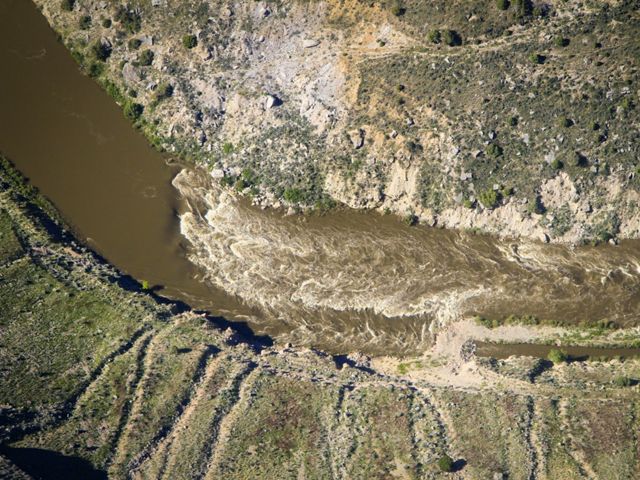
Local Partnerships: The Key to Lasting Results
That’s why TNC’s relationships with ranchers like Bruchez are so important. For years, Bruchez has worked with university scientists, government experts and nonprofit groups on river restoration, installing riffle structures that create habitat for fish and insects, cool the water and raise the water level so that it continues to reach irrigation pumps. Bruchez is now working with TNC on a multi-year research project to understand the impacts of different irrigation regimens on grass fields and hay meadows, the dominant irrigated crops in western Colorado.
“We need to not be afraid right now to try stuff,” he says. “If we do nothing, that’s failure. We don’t have 20 more years to do this. It’s time to throw the bowl of spaghetti at the wall and see what sticks.”
As a community leader, Bruchez is the liaison between many other local ranching families and TNC. TNC’s ongoing work with the community to develop better ways of growing crops involves multiple ranches whose participation is key. “It wouldn’t be possible without someone like Paul in the community,” explains Derwingson. “He’s the point person for our on-the-ground projects.”
Learning how to get by with less water won’t be easy. The ecological impacts of the changing climate are complex, as are the political aspects of sharing water fairly among different states, industries and populations—all while leaving enough water in the river for nature.
“That’s why we need partners in the ranching community, with the state and federal governments, with the universities and more,” Derwingson says. “It will take everyone with a stake in the system to solve this puzzle.”
Stay connected
Sign up to receive regular updates about our work in Colorado.
